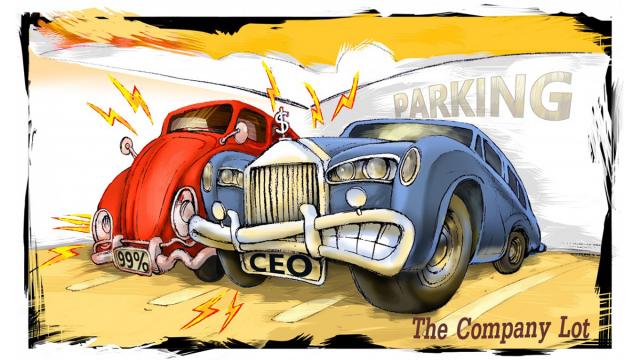
With national policy likely to compound the income and wealth gap in the coming years, states and localities are fighting back.
Across the country, local jurisdictions aren’t waiting for federal action or corporate governance reforms to close the wage gap. In December, for example, the city of Portland, Oregon, passed an ordinance to raise the business tax on companies with CEOs who earn more than 100 times the median pay of their workers. Portland officials said the ordinance is the first of its kind in the country. And now, more cities and states are poised to follow suit.
“The huge divide in income and wealth has real-world implications,” Steve Novick wrote last October in Inequality.org. Novick sponsored the ordinance when he was on the Portland City Council. “Too many Americans cannot get a leg up,” he wrote. “Income inequality undermines the American dream.”
Portland city government projects the tax will raise $2.5 million to $3.5 million a year, which city officials have said will likely help pay for the city’s homeless programs.
Inspired by the Living Wage Movement
Portland’s ordinance comes on the heels of decades of grassroots activism around the issue of wage inequality.
Starting in the 1990s, the failure of Congress to adequately raise the federal minimum wage gave rise to a prairie-fire movement of local activists pressing for local and state living wage ordinances. Living wage ordinances typically cover a segment of workers, such as employees of government contractors, while minimum wage laws cover all workers. By 2010, over 120 jurisdictions had passed local living wage laws, and at present, 41 jurisdictions have passed minimum wage laws.
“I expect this pay gap reform movement to spread like wildfire, just as the living wage movement did,” said Sarah Anderson from the Institute for Policy Studies. “I’ve gotten inquiries from over two dozen states and cities about how to establish a pay gap ordinance.”
Anderson lobbied the Portland City Council in support of the policy and testified at a public hearing. She has since compiled resources for communities interested in instituting a CEO-worker pay gap penalty.
Statewide laws similar to the Portland ordinance have also been proposed in Illinois, Massachusetts, Rhode Island, Minnesota, and Connecticut.
Meanwhile, some CEOs are advocating against these reforms. The conservative Business Roundtable, for example—which is an association of CEOs nationwide—has identified the repeal of federal pay ratio disclosure regulations as one of its top priorities.
Runaway CEO Pay Problem
The statistics showing the widening pay gap between CEOs and their workers are stunning. In the mid-1960s, the gap was about 20 to 1. By 2014, the gap had swollen to about 300 to 1.
“Skyrocketing CEO pay is one of the drivers of increased U.S. income concentration,” Anderson says.
Between 1979 and 2007, rising pay for corporate executives was a “major factor” contributing to income expansion for the top 1 percent, according to a 2015 report by the Economic Policy Institute. Meanwhile, worker wages have largely stagnated since the late 1970s.
Runaway CEO pay contributes to income inequality, but it also harms companies. CEO pay practices drove the reckless bonus culture that fueled the 2008 economic meltdown. And corporate governance experts recognize that large pay disparities are bad for company performance and undermine morale within firms.
As a result, company shareholders globally have tried to rein in excessive pay. And as part of the Dodd-Frank financial reform legislation, public corporations will have to disclose their CEO-worker pay ratio, starting with their 2017 pay figures.
Nationally, some federal and state lawmakers have proposed capping the tax deductibility of CEO pay. Currently, corporations can deduct unlimited amounts of so-called performance pay, including stock options and certain types of bonuses. This means that the more corporations pay their CEOs, the less they pay in taxes. Sens. Jack Reed and Richard Blumenthal and Rep. Lloyd Doggett are leading efforts to get rid of this perverse loophole.
Recently, these lawmakers reintroduced the 2017 Stop Subsidizing Multimillion Dollar Corporate Bonuses Act, which would treat bonuses as salaries and cap their deductibility at $1 million.
Several other federal lawmakers—including Reps. Mark DeSaulnier and Bonnie Watson Coleman—have championed the CEO Accountability and Responsibility Act to link federal tax rates to companies’ CEO-worker pay ratios. The Act increases rates on companies with a relatively large CEO-worker pay gap and reduces taxes on companies with a relatively small pay gap.
But with a Wall Street-friendly Congress and a Trump administration likely to block federal reforms to address the CEO-worker pay gap, the arena of struggle will likely be at the local and state level.
The Portland Ordinance
The Portland ordinance shows what local jurisdictions can do to address runaway CEO pay.
It applies to large corporations with the most egregious pay disparities. Portland government has identified over 500 such companies. A number of these top the annual list of CEO compensation, including Honeywell, Oracle, Wells Fargo, General Electric, and Goldman Sachs. The ordinance only applies to public corporations like these because they are required to disclose their pay ratio through the new federal disclosure requirement.
Most private and smaller- to medium-size public businesses in the city will not be subjected to the tax. Portland city government projects that 88 percent of revenue will come from the top 10 percent of corporate taxpayers; if you expand that to include the top 20 percent of corporate taxpayers, then it’s 96 percent.
Wall Street’s representatives in Congress will be working to gut the federal disclosure law for pay ratios in the coming year. But cities and states have the ability to address runaway inequality. Watch for more local jurisdictions to push forward CEO-worker pay gap reform.
3 WAYS TO SHOW YOUR SUPPORT
- Log in to post comments
















